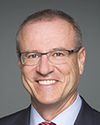Thank you very much, Madam Chairman.
I have with me Richard Neville, who is our chief financial officer and known to a number of people on the committee as well, as well as Marguerite Nadeau, who is our vice-president and general counsel at the Royal Canadian Mint.
Welcome, everyone. Madam Chair, and Honourable Members, thank you for the opportunity to appear before you today. It is truly a privilege to be here and speak on behalf of a unique and world-class organization such as the Royal Canadian Mint.
Ladies and gentlemen, I am no stranger to parliamentary committees. However, this is a first for me since my appointment last June as President and CEO of the Royal Canadian Mint. It is an appointment that I welcomed and I can tell you that I have not had one second of regret or hesitation since taking on this important and challenging responsibility.
As a former Deputy Minister of Finance, I came to the Mint somewhat familiar with the role it plays in our country's finances. Allow me, if you will, to provide a brief overview of the Royal Canadian Mint.
The Mint, as many around the table know, is a commercial crown corporation mandated to make a profit for its shareholder, the Government of Canada. Its most significant business is the production and distribution of circulation coins for Canada. Over the years, the Mint has developed and patented various innovative technologies, which include the manufacturing of coins that are of high quality yet use minimal amounts of costly metals such as copper and nickel, significantly reducing the cost of manufacturing and allowing for a greater return to the Government of Canada.
We also operate three other business lines: foreign circulation, Canadian numismatics or collector coins, and bullion products and refinery. Although our mandate is primarily to produce coins for Canada, part of our revenues are generated outside the country from the production of foreign circulation coins for central banks and foreign governments. Our plated technology has opened doors for the Royal Canadian Mint on the international scene by offering central banks a cost-effective alternative to very expensive alloy coins. We have seen the shift occur with the recent decision by New Zealand to change all their coins to our technology and in the process save millions of dollars.
I visited some of our customers, and I can say with great confidence that we enjoy an outstanding reputation internationally. We also produce and sell collector coins in Canada and abroad. Our coin designs celebrate Canada's culture, history, achievements, and values. We enjoy a strong reputation for quality and craftsmanship.
Finally, the Mint produces and markets a family of gold, silver, and palladium investment-grade products and operates a refinery that offers processing, refining, assaying, and secure storage of gold and silver.
The past few months have been truly an eye opener for me as I was introduced to the Mint's operations and met the employees. My initial impressions have been overwhelmingly positive. I have been struck by the level of professionalism and collective purpose. There is a sense of pride in the Mint's accomplishments and a strong identification with an organization that is so fundamentally linked to some of our most powerful and evocative symbols, some would even say icons of our nation and its identity.
I've been fascinated by the intricacies and the nuances of the fiercely competitive international minting market. I've been impressed by the leadership and business acumen of those who maintain the Royal Canadian Mint's leading position within that market. Above all, I can assure you it is a well-disciplined, highly motivated, and successful team with a winning attitude.
So you may ask, what do I bring to this team? Perhaps I should share with you what I told employees at a series of town hall meetings held last summer.
My vision for the Mint come down to three things. First, we want to maintain profitable growth, returning a profit to our shareholder, the Government of Canada, by introducing initiatives designed to stimulate top-line revenues, manage costs and grow our profits. Second, we want to maintain our international reputation for leadership, innovation and quality. Third, we want to remain an employer of choice. I am extremely proud of the fact that we were listed as one of Canada's top 100 employers in 2006 by Maclean's Magazine and intend to keep us on that list.
When I first met with employees, many of them asked about my management style. I told them the following: that I value the experience, wisdom, and views of others; that I believe in being open, clear, and direct about shared expectations and goals; that I am not a change management guru. Put simply, I'm a graduate of the school that teaches the fundamental axiom of good management, which is, if it isn't broken, don't fix it. I expect transparency, and above all, accountability. I also told them that while I encourage open, lively debate on the issues, the ultimate responsibility for decisions is mine. These are the principles that will guide my actions and decisions and they are what I bring and offer to the people of the Mint.
Yet, that responsibility and duty is made more pleasant when one has good news to share.
Honourable Members, as guardians of the public purse, I know you will be pleased to hear that for the third year in a row, the Mint will be reporting double digit profits.
Madam Chair, I invite all members of this Committee to read the good news stories contained in our Annual Report, when tabled by our Minister later this spring.
So this is further testament to the outstanding team that I have the honour and privilege to lead.
However, I would be shirking in my duty if I did not address issues that have been of concern and perhaps speak to the mandate of this committee.
Accountability and responsibility are two principles and concepts that go to the very heart of our society, our government, and the basic notion of how we view ourselves. Needless to say, they have been quite topical of late, and continue to be an important element of the public agenda. To maintain the Mint's competitiveness and credibility, we must continue to improve ways through which we demonstrate accountability and embrace the responsibility to become even more efficient in our business practices. We are doing that.
Is there room for improvement? You bet there is--there always is. We will shortly receive an independent report that will recommend a number of ways through which the Mint can improve efficiencies and realize considerable savings. In regard to increased accountability and transparency, we are linking strategies to the corporate objectives and we are developing better performance indicators. Starting in 2007, we will post on our website the travel and hospitality expenses of our board and senior managers on a quarterly basis. Such actions will only serve to further solidify the Mint's reputation as an efficient, accountable, and successful enterprise, which is fully transparent to the ultimate shareholder, the Canadian taxpayer.
Through you, honourable members, I would like to assure Canadians that the Royal Canadian Mint has been built upon a proud past and is today a modern, sophisticated, and dynamic business that successfully combines art with technology. Its record, accomplishments, products, and, most important of all, its people should be a source of pride to Canadians.
On that note, I would like to take advantage of this occasion and put my marketing hat on and present to you the Mint's 2010 Olympic Coin Program which I had the honour to unveil late last month.
I know you will join me in acknowledging their beauty and the sheer artistry that has created them.
It is the most ambitious circulation coin program ever conceived and undertaken by the Mint. It will feature no less than 17 circulation coins and 36 beautifully crafted collector coins and products.
In closing, please accept a personal invitation to come and visit our operations and our team. Unfortunately, I must advise you, though, that unlike chocolate factories and brewery tours, there are no free samples.
Thank you. I'd be more than happy to answer any questions you may have.
Thank you, madam.




